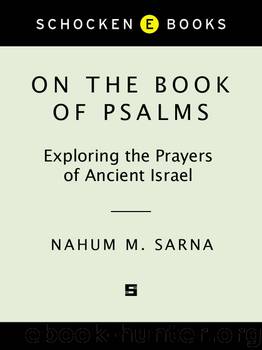On the Book of Psalms: Exploring the Prayers of Ancient Israel by Nahum M. Sarna

Author:Nahum M. Sarna [Sarna, Nahum M.]
Language: eng
Format: epub
ISBN: 978-0-307-76147-7
Publisher: Schocken Books
Published: 2010-12-28T16:00:00+00:00
It is “the house assigned for all the living”19 irrespective of one’s station in life,20 a site furnished with gates21 and divided into compartments.22 “The Pit” is an alternative term for Sheol, although originally it may have signified the passageway in the earth by which the dead were thought to descend to Sheol. At any rate, the cliché for the dead is “those who go down into the Pit.”23
Anyone familiar with Mesopotamian conceptions of the after-life24 will recognize at once the affinities with the biblical descriptions, most of which appear in poetic texts. In Akkadian literature, the realm of the dead is “the place of darkness,”25 “the land of no return.”26 It is surrounded by walls, and its innermost section is reached by passage through seven gates.27
Certainly, the biblical poetic references carry no doctrinal authority, and later Judaism developed an entirely different portrayal of the afterlife with its own specialized nomenclature. Moreover, the surface similarity between the biblical and Mesopotamian descriptions hides the fact that biblical law distanced the religion of Israel from that of its neighbors by prohibiting necromancy, the practice of communicating with the dead (to predict the future or for other purposes),28 and by outlawing sacrifices to them.29
To return to the two clauses of verse 4: how can the psalmist declare at one and the same time that God brought him up from Sheol and preserved him from going down into the Pit? The first clause implies an actual descent into the realm of the dead, while the second asserts escape from death.30 The answer is that Sheol in this context is a metaphor for imminent mortal danger.31 Hence, verse 4 has nothing to do with the late doctrine of the bodily resurrection of the dead. The identical idiomatic usage occurs in Mesopotamian literature in which the Akkadian divine epithet muballit miti, literally “giving life to the dead,” connotes “healing the mortally sick.”32
We have previously observed that the expression of gratitude through the medium of praise takes place in the presence of an assembled congregation, and that what appears to be a private event is inseparable from the life of the community. All the worshipers share each other’s joys and sorrows, and so our psalmist summons them to celebrate with him:
O you faithful of the Lord, sing to Him,
and praise His holy name.33
For He is angry but a moment,
and when He is pleased there is life.34
One may lie down weeping35 at nightfall;
but at dawn there are shouts of joy.36
Download
This site does not store any files on its server. We only index and link to content provided by other sites. Please contact the content providers to delete copyright contents if any and email us, we'll remove relevant links or contents immediately.
| Hebrew Bible (Old Testament) | Talmud |
| Torah | Zohar |
The Secret Power of Speaking God's Word by Joyce Meyer(2968)
Man's Search for Meaning by Viktor E. Frankl(2603)
Mckeown, Greg - Essentialism: The Disciplined Pursuit of Less by Mckeown Greg(2380)
MOSES THE EGYPTIAN by Jan Assmann(2372)
Devil, The by Almond Philip C(2279)
The Complete Dead Sea Scrolls in English (7th Edition) (Penguin Classics) by Geza Vermes(2231)
Unbound by Arlene Stein(2228)
I Capture the Castle by Dodie Smith(1983)
Schindler's Ark by Thomas Keneally(1828)
The Invisible Wall by Harry Bernstein(1762)
The Gnostic Gospel of St. Thomas by Tau Malachi(1736)
The Bible Doesn't Say That by Dr. Joel M. Hoffman(1652)
The Secret Doctrine of the Kabbalah by Leonora Leet(1574)
Political Theology by Carl Schmitt(1542)
The Jewish State by Theodor Herzl(1505)
A History of the Jews by Max I. Dimont(1482)
The Dead Sea Scrolls Bible by Martin G. Abegg(1466)
The Book of Separation by Tova Mirvis(1457)
Oy!: The Ultimate Book of Jewish Jokes by David Minkoff(1331)
